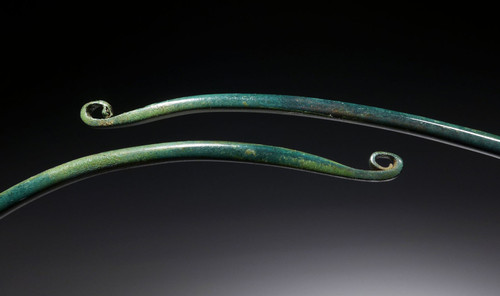Product Description
SEE MORE EUROPEAN BRONZE AGE ARTIFACTS
In all our travels in Europe touring the finest museums, we have yet to see a European Bronze Age major prestige pin of this magnitude outside of those museum cases. This primary ancient jewelry object of personal adornment, status and wealth hails from the Middle Bronze Age of Central Europe. This museum-class bronze jewelry pin displays the highest level of metal-smithing skill in ancient time. Made both, by casting and hand-forging, a pin of this complex design required an extraordinary amount of work to make by hand and therefore, would only have been within the reach of the wealthiest class of citizens of the day.
This extraordinarily large pin features four stacked discoidal decoration terminating in the largest fourth flat lenticular head. The state of preservation is incredible, the absolute finest possible patina and natural soil sheen which European Bronze Age antiquities are so prized for. Of all the ancient bronze objects in the world, these European Bronze Age objects display the most spectacular patina when everything is perfect as in this case!
Cleaned and treated in our lab to protect and preserve the integrity of the metal and allow safe handling. Be wary of modern copies that plague the antiquity market today. We subject every artifact we offer for sale to rigorous inspection and authentication in our own museum lab facility.
HISTORY
The Tumulus culture dominated Central Europe during the Middle Bronze Age (c. 1600 to 1200 BC). It was the descendant of the Unetice culture. Its heartland was the area previously occupied by the Unetice culture besides Bavaria and Württemberg. It was succeeded by the Late Bronze Age Urnfield culture. The Tumulus culture was eminently a warrior society, which expanded with new chiefdoms eastward into the Carpathian Basin (up to the river Tisza), and northward into Polish and Central European Únětice territories. The culture's dispersed settlements centred in fortified structures.
As the name implies, the Tumulus culture is distinguished by the practice of burying the dead beneath burial mounds (tumuli or kurgans). The Tumulus culture was prevalent during the Middle Bronze Age. Tumuli have been used elsewhere in Europe from the Stone Age to the Iron Age yet, the term "Tumulus culture" specifically refers to the South German variant of the Bronze Age.
 US DOLLAR
US DOLLAR
 EURO
EURO
 AUSTRALIAN DOLLAR
AUSTRALIAN DOLLAR
 CANADIAN DOLLAR
CANADIAN DOLLAR
 POUND STERLING
POUND STERLING




















